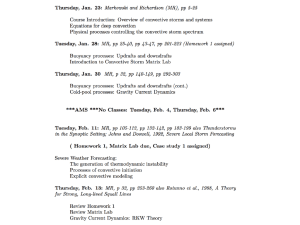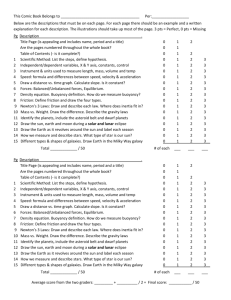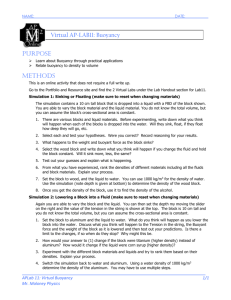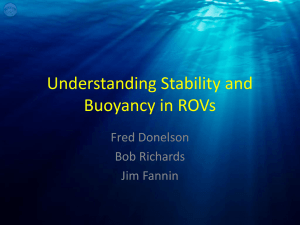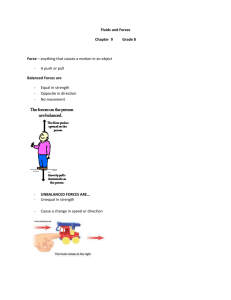Hydrostatic Force on a Submerged Surface
advertisement
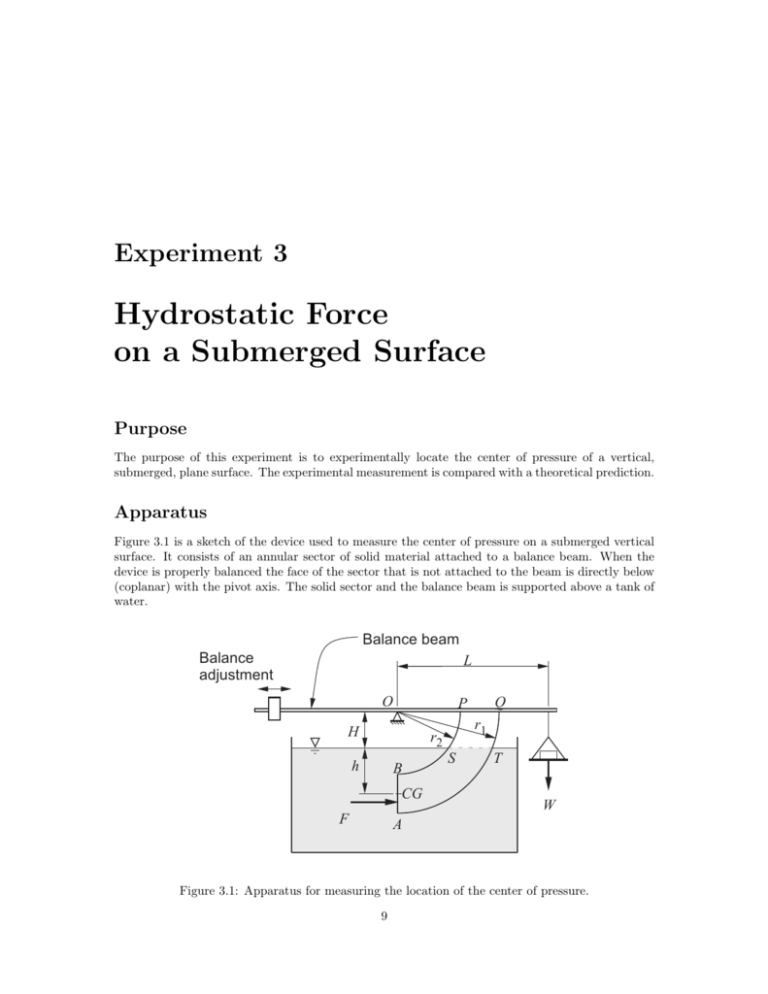
Experiment 3 Hydrostatic Force on a Submerged Surface Purpose The purpose of this experiment is to experimentally locate the center of pressure of a vertical, submerged, plane surface. The experimental measurement is compared with a theoretical prediction. Apparatus Figure 3.1 is a sketch of the device used to measure the center of pressure on a submerged vertical surface. It consists of an annular sector of solid material attached to a balance beam. When the device is properly balanced the face of the sector that is not attached to the beam is directly below (coplanar) with the pivot axis. The solid sector and the balance beam is supported above a tank of water. Balance beam Balance adjustment L O H r1 r2 h B CG F Q P S T W A Figure 3.1: Apparatus for measuring the location of the center of pressure. 9 10 EXPERIMENT 3. HYDROSTATIC FORCE ON A SUBMERGED SURFACE x y h yR Figure 3.2: Detailed nomenclature for locating the center of pressure. Theory Figure 3.2 shows the submerged surface viewed from the left side of the tank in Figure 3.1. The depth of the centroid below the surface of the water is h. The x-y coordinate system has its origin at the centroid. The y-direction position of the center of pressure, yR , is (Munson et al., §2.8) y R = yc + Ixc yc A (3.1) where Ixc is the moment of inertia of the surface about the x-axis, and A is the surface area. The location of the center of pressure can be measured using the apparatus sketched in Figure 3.1. The counterweight is adjusted so that the beam is horizontal when there is no water in the tank and no weight in the pan. When the tank is filled with water the unbalanced hydrostatic force causes the beam to tilt. Adding weight W to the pan at a distance L from the pivot O exerts a moment W L that counterbalances the resultant moment due to the hydrostatic forces on the quarter-annulus-shaped body ABP Q. When the water level is as shown in the figure, there are hydrostatic forces on surfaces AB, BS and AT . Since BS and AT are concentric cylindrical surfaces with the common axis passing through O, the hydrostatic forces on BS and AT do not exert any moment about O. As a result W L is equal to the moment due to the hydrostatic force F acting on the vertical plane surface AB. In this experiment the force F is not measured. Instead the theoretical value F = ρghA is assumed, where h is the depth of the centroid of the surface. The moment due to F is measured and the theoretical value of F is used to compute the location of the center of pressure. Balancing the moments about O gives W L = F (H + yR ) Substituting F = ρghA and solving for yR yields yR = WL −H ρghA (3.2) 11 Laboratory Procedure 1. Adjust the counterweight so that the balance the beam is horizontal with no water in the tank. 2. Add water up to some level. During the lab you will use at least four water levels. Make sure some water levels leave part of the vertical face exposed. 3. Add weights to the pan to restore the beam to a horizontal position. Record the weight. Measure H. 4. Measure and record h. 5. Calculate yR,th and compare to yR,m . If the values are not reasonably close, check your measurement procedure. 6. Return to step 2 and repeat the measurements using at least three other water levels. Analysis 1. Calculate yR from equation (3.1). Call this the theoretical value yR,th . 2. For each water depth, calculate yR from equation (3.2). Call this value the measured value yR,m . 3. Plot yR,th versus h and yR,m versus h on the same axes. 4. Plot yR,th − yR,m versus h. 5. Plot yR,th − yc versus h. The plots created in step 3 and step 4 allow a comparison of the theoretical and measured values of yR . The plot from step 4 shows the difference between the measured and theoretical values. A difference plot (like that required in step 4) is a good way to compare two quantities that have nearly the same value. For example, Figure 2.2 and Figure 2.3 in the lab manual for Experiment 2 are two plots of the calibration data for a pressure gage. The data in Figure 2.2 suggest that the calibration is quite good, but there is no indication of the magnitude of the errors. Figure 2.3 clearly shows the magnitude of the discrepancy between the indicated reading of the pressure gage and the dead weight tester. Furthermore, by plotting the calibration data as in Figure 2.3 one sees that the indicated pressure tends to be lower than the calibration standard (more points fall below the line pindicated − pdwt = 0). Report 1. How does the design of the apparatus enable the resultant force on the vertical surface to be measured? Are any significant forces being neglected? Does the section of the vertical surface that is above the water surface contribute any error to the measurement? 2. Compare the experimental and theoretical values of yR and explain any discrepancy. Pick one point in the middle of the range of measurements. For that data point, how much of a change in the measured yR would be caused by an error of 10 grams in the weight measurement? 3. What is the primary trend in yR − yc versus water depth? Is this consistent with the theory presented in lecture and in the textbook? 12 EXPERIMENT 3. HYDROSTATIC FORCE ON A SUBMERGED SURFACE Reference B.R. Munson, D.F. Young, and T.H. Okiishi, Fundamentals of Fluid Mechanics, 4th ed., 2002, Wiley and Sons, New York. Appendix: What About Buoyancy? Is the buoyancy force being neglected in the analysis of the experimental data? The answer is no. To understand why, we will consider two ways to analyze the experiment. The first analysis involves a moment balance that causes the buoyancy force to appear. The second analysis is the same as that presented in the preceding sections, and no buoyancy force appears. How can the buoyancy force be made to disappear? Remember that the buoyancy force is defined as the net pressure force acting on a submerged body. If we consider the pressure force components acting in the horizontal and vertical directions, then the buoyancy force contributes to the moment about the device pivot. If instead we consider the pressure forces acting normal to the surface of the acrylic arc, then the buoyancy force does not appear because the normal forces on the curved surface do not contribute a moment about the pivot of the device. This result is due to the design of the experiment. In other words, the person who designed this device chose the circular arc shape because it allows us to measure the hydrostatic pressure forces without accounting for the buoyancy effect. Initial Balance First consider the force balance on device when the apparatus is dry (the tank is empty), and the balance weight has been properly adjusted. This situation is depicted in Figure 3.3. The balance weight Wc is moved left or right until the moment Wc Lc is equal and opposite to the moment Wa La . When the tank is filled with water, pressure forces on the surface of the curved acrylic cause an additional moment. The moment due to the pressure forces is balanced by adding weights to the pan shown on the right side of Figure 3.3. Adding water does not affect the moment balance Wc Lc = Wa La because the water does not change the weight of the device. Lc La O Wc Wa Figure 3.3: Moments acting while balance weight is being adjusted and the tank is empty. 13 L Lc La O Lb Fb Wc W Wa Figure 3.4: Horizontal and vertical forces that create moments. Moments due to Horizontal and Vertical Forces Figure 3.4 shows the horizontal and vertical force components acting the acrylic after water is added to the tank. The horizontal forces are depicted as acting on vertical planes that are the projection of the curved surface. The contributions to the horizontal pressure forces on the left and right sides cancel exactly. Thus, by considering the horizontal pressure forces separately from the vertical pressure forces, we see that the net horizontal force must be zero. The horizontal force on the flat face of the acrylic does not appear separately because it is already included the balance of horizontal pressure forces. The vertical forces acting on the top and bottom of the curved surface create a buoyancy force Fb , which acts through the center of buoyancy. The center of buoyancy is the centroid of that portion of the acrylic that is submerged. The weight of the acrylic Wa acts through the center of gravity of the solid material. When the system is analyzed with the forces identified in Figure 3.4, the weight W creates a moment W L that balances the buoyancy force Fb Lb . The moment Wa La caused by the weight of the acrylic is still cancelled exactly by the moment from the balance weight Wc Lc . Moments due to Normal Forces Now consider the moment balance depicted in Figure 3.5. In this view only the force components normal to the surface are identified. No forces are neglected because the pressure force acts normal to the surface. In this particular apparatus it is easier to analyze the normal forces directly than to separate the forces into horizontal and vertical components. The local pressure force on the curved surface of the acrylic is not zero. However, the pressure forces on the curved surface do not contribute to moments about O because these forces have lines of action that pass directly through O. In other words, the device is cleverly designed to eliminate the contributions of all surface forces except the force acting on the vertical surface. A moment balance about point O shows that the moment F (H + h) is balanced by W L. The buoyancy force is not neglected. 14 EXPERIMENT 3. HYDROSTATIC FORCE ON A SUBMERGED SURFACE L O H+h W F Figure 3.5: Forces normal to curved surface. Summary of Buoyancy Affect The analysis of Figure 3.4 gives W L = Fb Lb (3.3) W L = F (H + h). (3.4) and the analysis of Figure 3.5 gives Thus, the weight can be used to measure either the magnitude of the buoyancy force or the magnitude of the net pressure force on the vertical face of the acrylic. To use Equation (3.3) we need to compute Lb , which requires locating the center of buoyancy. This is not trivial because the centroid of the submerged region of the acrylic is not a regular geometric shape.



